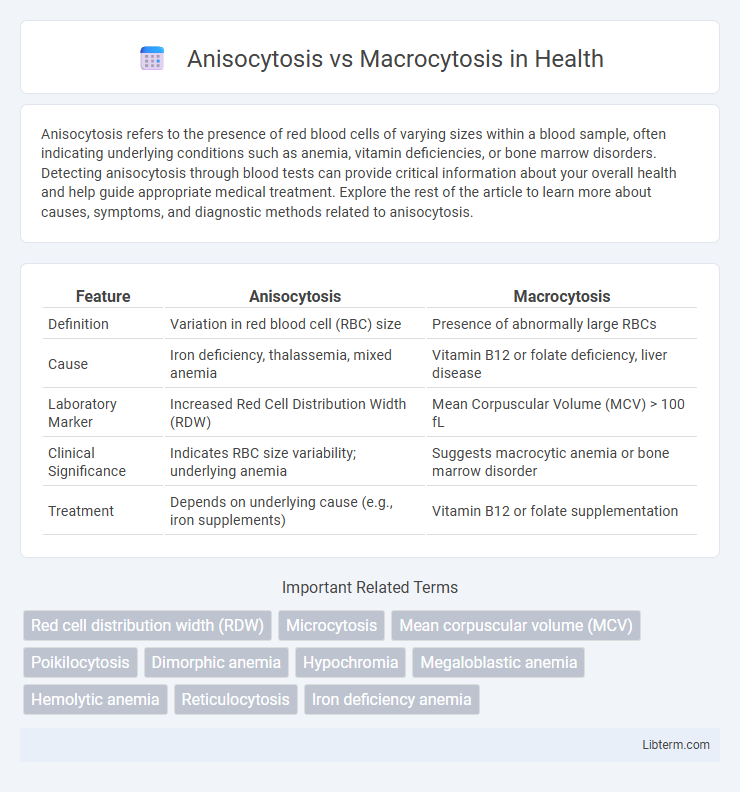Anisocytosis refers to the presence of red blood cells of varying sizes within a blood sample, often indicating underlying conditions such as anemia, vitamin deficiencies, or bone marrow disorders. Detecting anisocytosis through blood tests can provide critical information about your overall health and help guide appropriate medical treatment. Explore the rest of the article to learn more about causes, symptoms, and diagnostic methods related to anisocytosis.
Table of Comparison
| Feature | Anisocytosis | Macrocytosis |
|---|---|---|
| Definition | Variation in red blood cell (RBC) size | Presence of abnormally large RBCs |
| Cause | Iron deficiency, thalassemia, mixed anemia | Vitamin B12 or folate deficiency, liver disease |
| Laboratory Marker | Increased Red Cell Distribution Width (RDW) | Mean Corpuscular Volume (MCV) > 100 fL |
| Clinical Significance | Indicates RBC size variability; underlying anemia | Suggests macrocytic anemia or bone marrow disorder |
| Treatment | Depends on underlying cause (e.g., iron supplements) | Vitamin B12 or folate supplementation |
Understanding Anisocytosis: Definition and Causes
Anisocytosis refers to the presence of red blood cells (RBCs) of varying sizes in a blood sample, indicating an abnormal variation in cell size that can be detected through a peripheral blood smear or automated blood count. Common causes of anisocytosis include nutritional deficiencies such as iron deficiency anemia, vitamin B12 deficiency, and folate deficiency, as well as bone marrow disorders and chronic diseases. Distinguishing anisocytosis from macrocytosis, which specifically denotes abnormally large RBCs, is essential for accurate diagnosis and treatment planning in hematologic assessments.
What is Macrocytosis? Key Characteristics
Macrocytosis is a hematological condition characterized by the presence of abnormally large red blood cells, typically with a mean corpuscular volume (MCV) exceeding 100 femtoliters. Key characteristics include enlarged erythrocytes, which often indicate underlying issues such as vitamin B12 or folate deficiency, liver disease, or bone marrow disorders. Unlike anisocytosis, which refers to variation in red blood cell size, macrocytosis specifically denotes an increase in overall cell size.
Morphological Differences: Anisocytosis vs Macrocytosis
Anisocytosis is characterized by a significant variation in red blood cell sizes, where cells range from smaller to larger than normal, reflecting heterogeneity in erythrocyte volume. Macrocytosis specifically refers to an increased average red blood cell size, typically with a mean corpuscular volume (MCV) above 100 fL, indicating predominantly enlarged erythrocytes. Morphologically, anisocytosis presents a mixed population of cell sizes, while macrocytosis shows a uniform shift toward larger cells without the pronounced size diversity seen in anisocytosis.
Common Causes of Anisocytosis
Anisocytosis, characterized by unequal red blood cell sizes, commonly results from nutritional deficiencies such as iron deficiency anemia, vitamin B12 deficiency, and folate deficiency. Chronic diseases and bone marrow disorders also contribute to anisocytosis by disrupting normal erythropoiesis. In comparison, macrocytosis involves enlarged red blood cells and is frequently linked to vitamin B12 or folate deficiency, liver disease, and alcoholism.
Primary Etiologies of Macrocytosis
Macrocytosis primarily results from impaired DNA synthesis due to vitamin B12 or folate deficiency, leading to the production of enlarged red blood cells. Other significant etiologies include chronic liver disease, alcoholism, hypothyroidism, and certain medications such as hydroxyurea or methotrexate. Understanding the distinct causes helps differentiate macrocytosis from anisocytosis, which refers to a variation in red blood cell size without the characteristic enlargement seen in macrocytosis.
Diagnostic Approaches: Identifying Red Blood Cell Variations
Diagnostic approaches for anisocytosis and macrocytosis primarily involve peripheral blood smear examination and complete blood count (CBC) analysis. Anisocytosis is identified by variations in red blood cell (RBC) size quantified through red cell distribution width (RDW), while macrocytosis is characterized by an increased mean corpuscular volume (MCV) exceeding 100 fL. Advanced diagnostics may include reticulocyte counts and bone marrow biopsy to determine underlying causes such as anemia or bone marrow disorders.
Clinical Manifestations and Symptoms
Anisocytosis presents with varying red blood cell sizes leading to symptoms such as fatigue, pallor, and shortness of breath due to impaired oxygen delivery. Macrocytosis, characterized by enlarged red blood cells, often manifests with symptoms of anemia including weakness, glossitis, and neurological deficits when associated with vitamin B12 or folate deficiency. Both conditions require blood smear analysis for accurate diagnosis, as overlapping symptoms can complicate clinical assessment.
Laboratory Evaluation and Blood Tests
Anisocytosis is identified through a peripheral blood smear revealing red blood cells of varying sizes, often quantified by an elevated red cell distribution width (RDW) in a complete blood count (CBC). Macrocytosis is characterized by an increased mean corpuscular volume (MCV) above 100 fL, detected in CBC tests, indicating larger than normal red blood cells. Laboratory evaluation for macrocytosis includes serum vitamin B12 and folate levels to differentiate between megaloblastic and non-megaloblastic causes, while anisocytosis requires correlation with other indices like hemoglobin concentration and reticulocyte count for comprehensive diagnosis.
Treatment Options for Anisocytosis and Macrocytosis
Treatment options for anisocytosis focus primarily on addressing the underlying causes, such as nutritional deficiencies like vitamin B12 or iron, with supplementation being a common approach. Macrocytosis treatment typically involves correcting vitamin B12 or folate deficiencies through dietary changes or supplements, and managing any associated conditions like liver disease or alcoholism. Both conditions may require ongoing monitoring of blood counts and underlying disorders to ensure effective management.
Prognosis and Long-term Management
Anisocytosis indicates varying red blood cell sizes and often signifies an underlying condition, requiring precise diagnosis to guide long-term management and improve prognosis. Macrocytosis, characterized by enlarged red blood cells, commonly results from vitamin B12 or folate deficiency, necessitating targeted supplementation to prevent complications such as anemia or neuropathy. Prognosis depends on addressing the root cause through consistent monitoring, nutritional support, and managing associated disorders to enhance patient outcomes.
Anisocytosis Infographic

 libterm.com
libterm.com